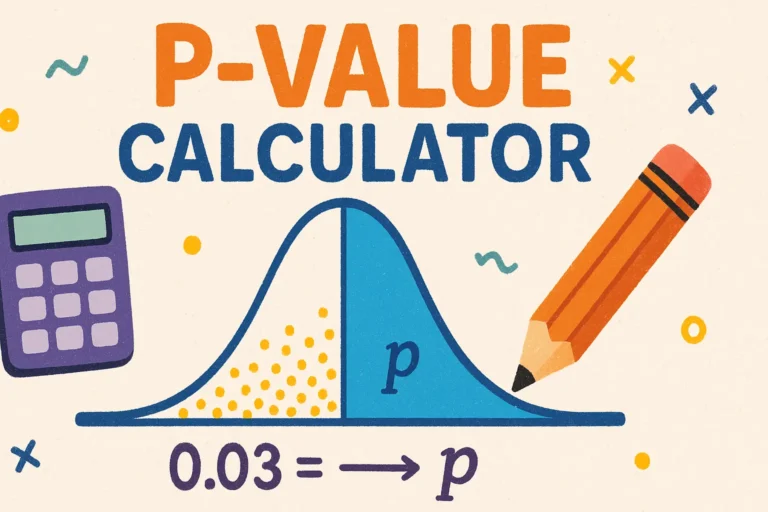P-Value Calculator: Determine Statistical Significance
A p-value calculator determines the probability value (p-value) that measures the strength of evidence against the null hypothesis in statistical hypothesis testing, calculating the probability of obtaining test results at least as extreme as observed results, assuming the null hypothesis is true. This essential statistical tool computes p-values from test statistics (z-scores, t-scores, chi-square values), supports one-tailed and two-tailed tests, interprets statistical significance at various alpha levels (0.05, 0.01, 0.001), and provides comprehensive analysis including confidence levels, critical values, and decision recommendations for researchers, data scientists, statisticians, students, and professionals conducting hypothesis tests, A/B testing, clinical trials, quality control analysis, survey research, and scientific studies requiring rigorous statistical inference and evidence-based decision making in research, medicine, psychology, business analytics, and experimental sciences.
📊 P-Value Calculator
Calculate p-values for statistical significance testing
Z-Test P-Value Calculator
Calculate p-value from z-score for large samples (n≥30)
T-Test P-Value Calculator
Calculate p-value from t-score for small samples
Chi-Square P-Value Calculator
Calculate p-value from chi-square statistic
Understanding P-Values
The p-value is the probability of obtaining test results at least as extreme as the observed results, assuming the null hypothesis is true. A small p-value (typically ≤ 0.05) indicates strong evidence against the null hypothesis, suggesting the observed effect is statistically significant and unlikely to have occurred by chance alone.
P-Value Formula and Calculation
General P-Value Concept
P-Value Definition:
\[ \text{p-value} = P(\text{obtaining test statistic} \geq \text{observed value} \mid H_0 \text{ is true}) \]
Where:
\( H_0 \) = null hypothesis
Test statistic = z-score, t-score, χ², F, etc.
p-value = probability under null hypothesis
Z-Test P-Value Formula
For Z-Score:
\[ z = \frac{\bar{x} - \mu_0}{\sigma / \sqrt{n}} \]
P-Value Calculation:
Two-tailed: \( p = 2 \times P(Z > |z|) \)
Right-tailed: \( p = P(Z > z) \)
Left-tailed: \( p = P(Z < z) \)
T-Test P-Value Formula
For T-Score:
\[ t = \frac{\bar{x} - \mu_0}{s / \sqrt{n}} \]
Where:
\( \bar{x} \) = sample mean
\( \mu_0 \) = hypothesized population mean
\( s \) = sample standard deviation
\( n \) = sample size
\( df = n - 1 \) (degrees of freedom)
Detailed Example
Example: Z-Test P-Value Calculation
Problem: A researcher tests if a new teaching method improves test scores (mean = 75). Sample of 36 students scores mean = 78, σ = 12. Test at α = 0.05.
Step 1: Set up hypotheses
H₀: μ = 75 (no improvement)
H₁: μ > 75 (improvement) — right-tailed test
Step 2: Calculate z-score
\[ z = \frac{78 - 75}{12 / \sqrt{36}} = \frac{3}{2} = 1.5 \]
Step 3: Find p-value
For z = 1.5 (right-tailed):
p-value = P(Z > 1.5) = 0.0668
Step 4: Decision
p-value (0.0668) > α (0.05)
Conclusion: Fail to reject H₀. Not enough evidence that teaching method improves scores at 5% significance level.
P-Value Interpretation Guide
| P-Value Range | Interpretation | Decision (α = 0.05) |
|---|---|---|
| p < 0.001 | Very strong evidence against H₀ | Reject H₀ (highly significant) |
| 0.001 ≤ p < 0.01 | Strong evidence against H₀ | Reject H₀ (very significant) |
| 0.01 ≤ p < 0.05 | Moderate evidence against H₀ | Reject H₀ (significant) |
| 0.05 ≤ p < 0.10 | Weak evidence against H₀ | Fail to reject H₀ (marginally significant) |
| p ≥ 0.10 | Little or no evidence against H₀ | Fail to reject H₀ (not significant) |
One-Tailed vs Two-Tailed Tests
| Aspect | Two-Tailed Test | One-Tailed Test |
|---|---|---|
| Hypothesis | H₁: μ ≠ μ₀ (different) | H₁: μ > μ₀ or μ < μ₀ |
| Use Case | Testing for any difference | Testing for specific direction |
| P-Value | 2 × P(|Z| > |z|) | P(Z > z) or P(Z < z) |
| Rejection Region | Both tails | One tail only |
| Example | Is drug effect different? | Does drug increase effect? |
Common Significance Levels
| Alpha (α) | Confidence Level | Critical Z-Value | Common Use |
|---|---|---|---|
| 0.10 | 90% | 1.645 (one-tail), ±1.645 (two-tail) | Exploratory research |
| 0.05 | 95% | 1.960 (one-tail), ±1.960 (two-tail) | Standard practice |
| 0.01 | 99% | 2.576 (one-tail), ±2.576 (two-tail) | High confidence needed |
| 0.001 | 99.9% | 3.291 (one-tail), ±3.291 (two-tail) | Very high confidence |
Real-World Applications
Medical Research
- Clinical trials: Test drug effectiveness vs placebo
- Treatment comparison: Compare surgical vs medical treatments
- Diagnostic tests: Evaluate test accuracy
- Epidemiology: Identify disease risk factors
Business & Marketing
- A/B testing: Compare website conversion rates
- Quality control: Test if process meets specifications
- Market research: Analyze customer preferences
- Product testing: Compare product performance
Academic Research
- Psychology: Test behavioral interventions
- Education: Evaluate teaching methods
- Economics: Analyze policy effects
- Social sciences: Study social phenomena
Tips for Using P-Values
Best Practices:
- Set alpha before testing: Avoid p-hacking by deciding significance level in advance
- Consider effect size: Statistical significance ≠ practical significance
- Report exact p-values: Don't just say "p < 0.05"
- Use confidence intervals: Provide more information than p-values alone
- Check assumptions: Verify test assumptions before interpreting
- Avoid multiple testing: Adjust for multiple comparisons
- Consider context: Interpret results within domain knowledge
Common Mistakes to Avoid
⚠️ P-Value Misinterpretations
- Wrong: p-value = probability H₀ is true — Correct: probability of data given H₀
- Wrong: p = 0.05 means 95% sure — Correct: 5% type I error rate
- Wrong: Non-significant means no effect — Correct: insufficient evidence
- Wrong: Lower p-value = stronger effect — Correct: check effect size
- P-hacking: Testing multiple hypotheses until finding p<0.05
- Cherry-picking: Reporting only significant results
- Wrong test choice: Using inappropriate statistical test
Frequently Asked Questions
What is a p-value and how is it calculated?
P-value is probability of obtaining test results at least as extreme as observed, assuming null hypothesis true. Calculated from test statistic (z, t, χ², F) using statistical distribution. Steps: (1) Calculate test statistic from sample data, (2) Find probability of that value or more extreme under null hypothesis distribution, (3) Compare to significance level (α). Example: z=2.0 gives p=0.0455 for two-tailed test. Lower p-value = stronger evidence against null hypothesis. Does not measure effect size or practical importance.
What does p-value < 0.05 mean?
P<0.05 means less than 5% probability of observing results this extreme if null hypothesis true. Conventional threshold for statistical significance in many fields. Indicates sufficient evidence to reject null hypothesis at 5% significance level. Does NOT mean 95% probability null hypothesis false or 95% confidence in result. Common misconception. Also doesn't indicate effect size or practical importance. 0.05 is arbitrary convention—other fields use 0.01 or 0.10. Always consider context, effect size, and practical significance alongside p-value.
When do you use one-tailed vs two-tailed tests?
Use two-tailed when testing for any difference (H₁: μ≠μ₀), most common and conservative. Use one-tailed when specifically testing increase (H₁: μ>μ₀) or decrease (H₁: μ<μ₀) and have strong theoretical reason to expect direction. One-tailed tests have more power to detect effects in predicted direction but cannot detect opposite effects. Example: two-tailed for "Does drug affect blood pressure?" One-tailed for "Does drug lower blood pressure?" Choose before seeing data—switching after is p-hacking.
What's the difference between p-value and alpha?
Alpha (α) is pre-determined significance level (threshold), typically 0.05. P-value is calculated from data after experiment. Decision rule: reject H₀ if p-value < α. Alpha is Type I error rate you're willing to accept (false positive). P-value measures strength of evidence against H₀ from specific dataset. Alpha set before data collection. P-value computed after. Example: Set α=0.05, get p=0.03, reject H₀ because p<α. If p=0.08, fail to reject H₀ because p>α.
Can p-values be greater than 1?
No! P-values always between 0 and 1 (or 0% to 100%). Represents probability, which cannot exceed 1. If calculation gives p>1, error in computation. Check: (1) correct formula, (2) proper test statistic, (3) right distribution, (4) degrees of freedom. Common errors: using wrong tail, incorrect standard error, arithmetic mistakes. P-values near 1 indicate observed results highly likely under null hypothesis (strong support for H₀). P-values near 0 indicate results unlikely under H₀ (evidence against H₀).
How do you calculate p-value from z-score?
Use standard normal distribution table or calculator. For two-tailed: p = 2×P(Z>|z|). For right-tailed: p = P(Z>z). For left-tailed: p = P(Z
Key Takeaways
P-values are fundamental tools in statistical hypothesis testing, providing a standardized measure of evidence against the null hypothesis. Understanding how to calculate, interpret, and apply p-values correctly is essential for making informed, data-driven decisions in research, business, and scientific inquiry.
Essential principles to remember:
- P-value is probability of data given null hypothesis is true
- Lower p-value indicates stronger evidence against null hypothesis
- P < α (usually 0.05) means statistically significant result
- Set significance level (α) before conducting test
- P-value does not measure effect size or practical importance
- Statistical significance ≠ clinical/practical significance
- Report exact p-values, not just "<0.05"
- Consider confidence intervals and effect sizes alongside p-values
- Avoid p-hacking and multiple testing without correction
- Understand test assumptions before interpreting results
Getting Started: Use the interactive calculator at the top of this page to calculate p-values from z-scores, t-scores, or chi-square statistics. Choose your test type (one-tailed or two-tailed), enter your test statistic value, and receive instant results with interpretation of statistical significance at various alpha levels. Perfect for researchers, students, data analysts, and anyone conducting hypothesis tests and statistical analysis.

